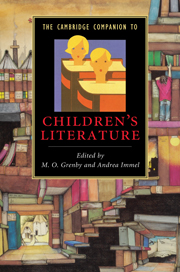Book contents
- Frontmatter
- Part I Contexts and Genres
- 1 The origins of children’s literature
- 2 Children’s books and constructions of childhood
- 3 The making of children’s books
- 4 Picture-book worlds and ways of seeing
- 5 The fear of poetry
- 6 Retelling stories across time and cultures
- 7 Classics and canons
- Part II Audiences
- Part III Forms and Themes
- Further reading
- Index
1 - The origins of children’s literature
from Part I - Contexts and Genres
Published online by Cambridge University Press: 28 November 2010
- Frontmatter
- Part I Contexts and Genres
- 1 The origins of children’s literature
- 2 Children’s books and constructions of childhood
- 3 The making of children’s books
- 4 Picture-book worlds and ways of seeing
- 5 The fear of poetry
- 6 Retelling stories across time and cultures
- 7 Classics and canons
- Part II Audiences
- Part III Forms and Themes
- Further reading
- Index
Summary
Many of the most celebrated children's books have a famous origin story attached to them. Lewis Carroll made up 'the interminable fairy-tale of Alice's Adventures' (as he called it in his diary) while he was on a boat-trip with Alice, Lorina and Edith Liddell in 1862; Peter Pan grew out of J.M. Barrie's intense friendship with the five Llewelyn Davies boys; Salman Rushdie, following the Ayatollah Khomeini's 1989 fatwa, wrote Haroun and the Sea of Stories for his son, Zafir, for Zafir, like Haroun, had helped his father recover the ability to tell stories. The veracity of these stories, and many others like them, is open to question. But their prevalence and endurance is nevertheless important. We seem to demand such originary myths for our children's classics. What we want, it appears, is the assurance that published children's books have emerged from particular, known circumstances, and, more specifically, from the story told by an individual adult to individual children. C. S. Lewis listed this as one of his 'good ways' of writing for children: 'The printed story grows out of a story told to a particular child with the living voice and perhaps ex tempore.' Such a creative method is an antidote to what Lewis thought the very worst way to write for children, striving to 'find out what they want and give them that, however little you like it yourself'.
- Type
- Chapter
- Information
- The Cambridge Companion to Children's Literature , pp. 3 - 18Publisher: Cambridge University PressPrint publication year: 2009
- 8
- Cited by

